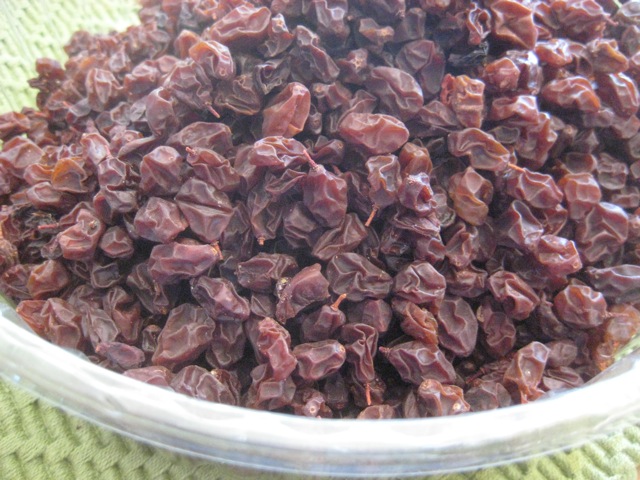 Yes, I am still on a food-drying binge! First it was kale, and tomatoes, which I made into “V8 powder“. . . then yellow squash, herbs of course, and finally green beans. Well, I am not done yet. Let me tell you about what we did with our grape crop.
Yes, I am still on a food-drying binge! First it was kale, and tomatoes, which I made into “V8 powder“. . . then yellow squash, herbs of course, and finally green beans. Well, I am not done yet. Let me tell you about what we did with our grape crop.
When the grapes come on, you can’t possibly eat them all. And I definitely don’t want to cook those luscious vitamin-bursting grapes into juice, destroying much of the vitamin C content in the process. I have frozen some and they make a good snack. And I have fresh-juiced them into raw grape juice to freeze, which is also yummy. I wanted a way, though, to preserve that high-sugar, high-nutrition, high fiber health morsel that a grape provides. So, I turned to my latest craze: drying.
Raisins were highly prized by the ancient Romans, who adorned their places of worship with them and used them as barter currency. Raisins were also the trophy for the winners of sporting events. I can see why, now that we’ve transformed some of our delicious grapes into raisins!
Here’s how:
Makin’ Raisins on Your Dashboard
Pick grapes at the peak of ripeness. Wash and remove from stems. Rig up a drying surface: a nylon stocking pulled over a baking dish works great. A window screen is even better. Those black plastic trays that hold seedlings at the nursery work well, with a piece of light cloth or paper towel in the bottom. The process goes faster if the air can circulate around the grapes, but it still works on a cookie sheet.
Spread the grapes onto whatever surface you choose, and put this on your car dashboard. Roll up all windows, face the car into the sun, and let Mother Nature do the work! You can use the back dashboard also, if sun comes in that window. It took about a week during the month of September for the grapes to dry into raisins that were quite dry. It can take a week longer if the sun is not intense.
You can still drive your car—just don’t come to any abrupt stops or you’ll end up with raisins in your lap. And the aroma of drying grapes is pretty sweet!
Taste them every few days and stop once they are the dryness you like. If you dry them very dry, they will store for years. Once the raisins are dry, store in an air-tight container. Unlike store bought raisins, our home-grown raisins are pesticide and preservative free!
Easy, breezy!
How do I use them?
I add them to the recipe of cookies, muffins, breads, and oatmeal. You can cover with hot water, wait 10 minutes, and you’ll have soft raisins. Use the nutritious, sweet, rehydrating liquid in your recipe too. My newest use is making a natural sugar substitute. Buzz very dry rasisins in your blender to make a natural sweetener granules to add as a sugar substitute when you bake. You can also use raisins as a sweetener by just adding them to the liquid ingredients in your recipe, buzzing until smooth in the blender. I’ve noticed “raisin juice” as an ingredient in some natural breads, so it’s not a new idea. They are sweet!
Just how nutritious are raisins? Raisins are one of the richest sources of the mineral boron, which increases bone health and prevents osteoporosis (bone softening). Studies have shown that boron reproduces many of the positive effects of estrogen therapy in postmenopausal women. Raisins are a fabulous source of antioxidants, which help prevent oxygen-based damage to cells in the body. They are low-fat, and contribute both B vitamins and iron to the diet. Research has shown they protect against Macular Degeneration, a degenerative disease of the eyes. They are pretty healthy!
No electricity is even needed to make raisins. They last almost forever (if you dry them quite dry and store air-tight) and they provide both sweetness and nutrition all year long. What a great food to store!



Comments on this entry are closed.